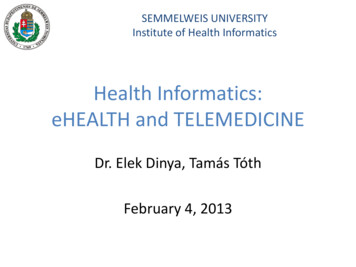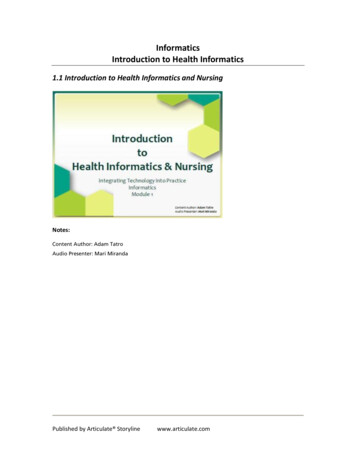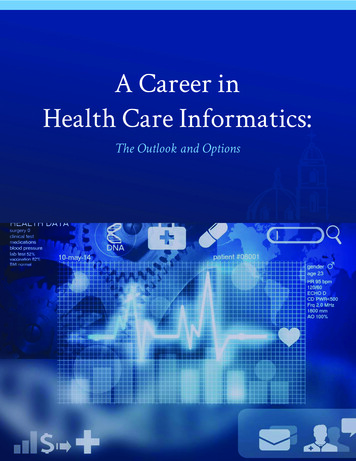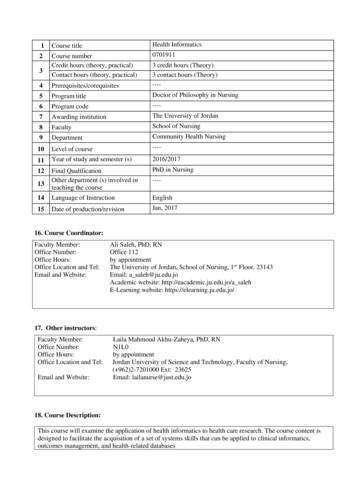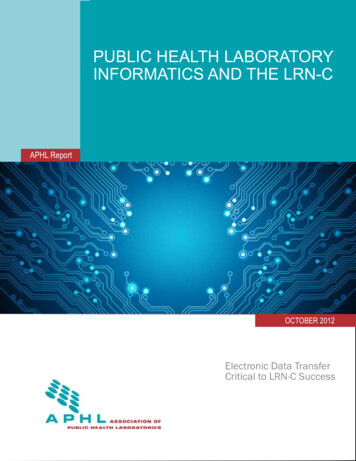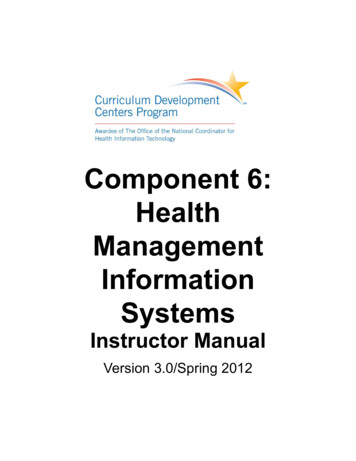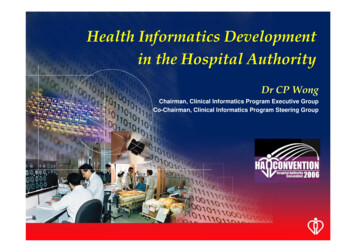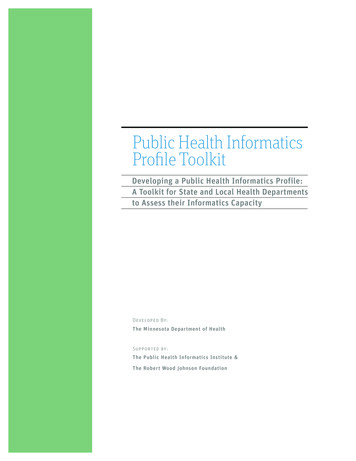
Transcription
Public Health InformaticsProfile ToolkitDeveloping a Public Health Informatics Profile:A Toolkit for State and Local Health Departmentsto Assess their Informatics CapacityDeveloped By:The Minnesota Department of HealthSupported by:The Public Health Informatics Institute &The Robert Wood Johnson Foundation
Public Health Informatics Profile ToolkitAcknowledgementsDeveloping a Public Health Informatics Profile: a Toolkit for State and Local Health Departments to Assess theirInformatics CapacityThe project was supported by the Robert Wood Johnson Foundation through an InformationLinks Grant to the PublicHealth Informatics Institute. The initial project (the Public Health Informatics Profile Assessment) was also funded byRobert Wood Johnson Foundation through their Common Ground grant program.The authors of the Public Health Informatics Toolkit wish to thank the many members of the Minnesota Departmentof Health for their time, their expertise, and for their contributions to the original Public Health Informatics ProfileAssessment.Jennifer Ellsworth Fritz, Priya Rajamani, Martin LaVentureMinnesota Department of HealthPrincipal DevelopersBill Brand, Debra RobicPublic Health Informatics InstituteEditorial ReviewersFor More InformationPublic Health Informatics InstituteVisit www.phii.orgCall toll-free (866)815-9704E-mail info@phii.orgMinnesota Department of HealthVisit www.health.state.mn.us/ehealthCall Priya Rajamani @ 651-201-4119E-mail Priya.Rajamani@state.mn.usCall Jennifer Ellsworth Fritz @ 651-201-3662E-mail Jennifer.Ellsworth@state.mn.us2
Public Health Informatics Profile ToolkitTable of Contents1 Introduction042 Purpose of a Public Health Informatics Profile0707What is a public health informatics profile?08Why conduct a public health informatics profile?08Who would benefit from a public health informatics profile?3 Getting Started1010How do we develop a conceptual view of the project?11How do we define project scope?13How do we define our goals for a public health informatics assessment?4 Assessment Methods1616How do we establish inclusion and exclusion criteria?16What questions should we consider?17Now that we know what we want, how should we collect the information?18How should we conduct the assessment?5 Interpreting the Results1919What should we consider about analyzing the data?6 Creating a Public Health Informatics Profile2020What should we consider about interpreting and communicating the results?7 Acting on the Results2323How can we use the results to support planning efforts?24Now that we have the assessment information, what do we do with it?8 Additional Resources9 Appendices 2625Appendix APublic Health Informatics Profile Project CharterAppendix BPublic Health Informatics Profile Project Scope StatementAppendix CPublic Health Informatics Profile Conceptual Framework DiagramAppendix DPublic Health Informatics Profile Assessment ToolAppendix EPublic Health Informatics Profile ReportAppendix FSample PowerPointAppendix GSample Memo to accompany Profile ReportAppendix HSample Project Charter to Accompany Profile ReportAppendix IStakeholder Analysis and Communication Strategies3
Introduction1Public Health Informatics Profile ToolkitIntroductionPublic health plays a critical role in the collectionand dissemination of health information (e.g.,immunization registries, disease reporting, anddisease registries). However, the systems thatsupport this information are often fragmented,particularly at the state and local level, and affordlittle opportunity for inter-program communication. A challenge facing the entire health caresystem is the need for timely and accurate healthinformation and a more integrated informationsystem. This has prompted the private sector tomove towards more standards-based, electronichealth information exchange. Such environmentaland systems changes are being driven and supported by several federal policy initiatives, suchas the Health Information Technology for Economic and Clinical Health (HITECH) Act and thenational eHealth Initiative as well as state-basede-health initiatives (see Additional Resourcessection on page 25 for more information). Thechallenge for public health is to respond inkind by overcoming common barriers, includingcompeting priorities, lack of funding and otherresources, and a lack of understanding of the bigpicture. Public health must strategically approachthe modernization (see definition on page 6) of itsinformation systems.With this in mind, the Minnesota Departmentof Health (MDH) designed the Public HealthInformatics Profile Toolkit. The Toolkit is aresource for state and local health departmentsto assess needs and readiness for health information exchange in today’s rapidly changinghealth information environment. It is meant tobe an adaptable set of resources that can betailored to your agency’s individual needs, andis based upon the work done by the MDH’s ownassessment regarding its readiness for electronicinformation exchange.4
Public Health Informatics Profile ToolkitBelow are definitions of frequently used terms inthis Toolkit.AssessmentAs used in this document, the term refers to theprocess for conducting an evaluation of youragency’s current and projected information system needs and opportunities, which includes developing a conceptual framework, project scope,and goals in order to fashion a detailed publichealth informatics profile for your organization.Common GroundThis program facilitates the exchange of ideasand best practices in the areas of public healthpreparedness and chronic disease prevention andcontrol. The Public Health Informatics Instituteprovides management and technical supportto 31 initiative grantees (including the MDH),helping state and local public health agenciesto better respond to health threats by improvingtheir use of information systems through analysisand redesign of business processes, and defininginformation system requirements. The program is sponsored by the Robert Wood JohnsonFoundation.DatasetA dataset is a collection of records, electronic orpaper-based, organized for a particular purpose.Some small datasets could logically be groupedtogether. For example, several datasets aboutfood-borne outbreaks could be grouped togetherbecause, even though each dataset tracks anindependent outbreak, all of the datasets containessentially the same kind of information.Data StandardsStandards facilitate the electronic movement ofdata across various information systems. In orderto share and utilize data across numerous organizations / departments, data must hold similarinformation (data elements), utilize similar words(vocabulary), and use an agreed upon way to communicate (messaging). When information systemscollect and store data in the same way, it is muchmore efficient for one system to send that data toanother and that data can be utilized accuratelyand consistently for its intended purpose.IntroductionFrequently Used Termsin this Toolkit1Health Information ExchangeThis term describes the mobilization of healthcareinformation electronically across organizationswithin a region or community. Health informationexchange provides the capability to electronically move clinical information between disparatehealthcare information systems while maintainingthe meaning of the information being exchanged.The goal of health information exchange is tofacilitate access to and retrieval of clinical datato provide safer, timelier, efficient, effective,equitable, and patient-centered care.HITECHThe Health Information Technology for Economicand Clinical Health (HITECH) Act, part of theAmerican Recovery and Reinvestment Act (ARRA),has set a goal of 2014 to increase the number ofhealth care providers who have, and effectivelyuse, electronic health records (EHRs) and healthinformation exchange (HIE).Note: Public health agencies are viewed ascritical electronic health information exchangestakeholders that are expected to assess theirinformation systems (particularly for diseasereporting and immunization registries) to be ableto exchange health information when needed.InformationLinks (InfoLinks)A collaborative project of the Public HealthInformatics Institute and the Centers for DiseaseControl and Prevention’s National Center for Public Health Informatics. The project assists publichealth departments in partnering with the privatehealthcare sector on Health Information Exchange(HIE) issues, and facilitates a community of practice comprised of public health practitioners who5
Introduction1Public Health Informatics Profile Toolkitseek to use HIE as a means of improving healthcare quality and safety and population health.Information SystemThis term, as it is used in the Toolkit, refers to abusiness application of the computer. It is madeup of the database, application programs, aswell as manual and machine procedures. It alsoencompasses the computer systems that do theprocessing. The database stores the subjectsof the business (master files) and its activities(transaction files). Application programs provide the data entry, updating, query, and reportprocessing. Examples of public health informationsystems include cancer surveillance, immunization registries, disease surveillance, and vitalrecords.Information System ModernizationThis term is used in the Toolkit to describe theprocess and outcome of upgrading or modifyingan information system to meet changing needs.Modernization may include: upgrading software,developing a web-based interface, utilizing morecurrent versions of standards, modifying theuser interface, enhancing a system to accept orexchange information electronically, etc.InteroperabilityThe ability of information technology systemsfrom various programs and software applicationsto communicate, to exchange data accurately,effectively, and consistently, and to use the information that has been exchanged.Personal Health InformationPersonal Health Information means individuallyidentifiable health information that is transmittedor maintained by electronic media or is transmitted or maintained in any other form or medium.“Health information” is any information relatingto the past, present, or future physical or mentalhealth or condition of an individual.6Public Health InformaticsThe systematic application of information andcomputer science and technology to public healthpractice, research, and learning.Public Health Informatics ProfileThis term refers to the end result of the assessment; the report that is generated based on theinformation derived from the assessment.ToolkitWe use this term to refer to the resources described in this document, which describes theassessment process, the methods used, and theresultant profile.
Public Health Informatics Profile ToolkitWhat is a public healthinformatics profile?A public health informatics profile is a comprehensive summary of an agency’s current andprojected information system needs and opportunities. The profile can be used to informyour agency decisions and priorities regardingsystem modernization (as defined on page 6). Forexample, priorities may be based on needs forelectronic connections with public and privatestakeholders. Information in your public healthinformatics profile can include the collection,analysis, and representation of informationpertaining to the information systems that support your public health programs, as well asan assessment of future informatics needs andopportunities.The information can be collected at the agency orother organizational level. The profile can includevarious relevant areas such as: Current and desired technical capabilities ofinformation systems Current and future use of and need for publichealth information Current and desired information exchangepartners and capabilitiesPurpose of a Public Health Informatics ProfilePurpose of aPublic HealthInformaticsProfile2 Resource needsThe Public Health Informatics Profile Toolkit ismeant to serve as a guide that you can use tocreate a public health informatics profile. TheToolkit provides practical tips and direction fortailoring a profile that realistically reflects yoursystem needs. Ultimately the profile must meetthe specific system requirements of your agency,therefore, these tools are not meant to be acookbook, but rather a set of ingredients that youassemble in a recipe that meets your needs.Note: Sample tools are referenced throughout theToolkit and can also be found in the appendices.7
Purpose of a Public Health Informatics Profile2Public Health Informatics Profile ToolkitWhy conduct a publichealth informatics profile?The need for public health agencies to electronically exchange information with our stakeholdersis growing, and the expectations for high levelsof service requires modernization of many of ourinformation systems by making them integrated,interoperable, and standards-based.Any public health organization responsible forcollecting, managing, or using public health datacan benefit from conducting the kind of assessment we describe in the Toolkit to generate a public health informatics profile. An assessment ofpublic health information systems including thetechnical as well as human skill and knowledgeresource aspects can help your agency identifyareas of opportunity, and assist in agency-wideplanning efforts. A public health informatics profile can provide your organization with a portfolioof program and/or information system needs,human resource needs, and reveal departments ordivisions where there may be synergies for working together on a similar issue, such as electronichealth information exchange.For public health to become an important playerin health care reform, public health agencies willneed to upgrade their systems in order to be anequal partner in health information exchangeinitiatives with the private health care sector(HITECH funding may support the developmentof this type of exchange). Conducting a readinessassessment for your organization can provideuseful information for planning purposes, andcan become a motivator for change within yourorganization.Who would benefit from apublic health informaticsprofile?Depending on the needs of your agency, the public health informatics assessment as described inthis Toolkit can be conducted to evaluate key information systems on a program-specific level, or8can provide an enterprise-wide view. Therefore,a public health informatics profile can benefit individuals at all levels of an organization, whetheryou are an executive responsible for overallorganizational leadership or a program managerresponsible for a particular program area.For example, executives benefit by having anoverall assessment to support strategic andtactical planning and overall information systemportfolio management. Individual program staffcan benefit from an assessment conducted withinan organization, which can reveal those programsthat are exchanging data electronically, whichones are not, and where some of the gaps arein the process. The assessment can also exposeareas of opportunity to coordinate within anagency. For example, a program manager whoneeds to implement electronic exchange withhospitals or clinics can see which programs arealready doing this and can benefit from theirexperience by partnering with them on staff andother shared resources.An assessment can also be conducted outside ofthe organization, providing a better picture ofneeds and opportunities in the external environment. For example, the readiness of healthinformation exchange among community partners(hospitals, etc.) can be determined.A Minnesota storyAs momentum was building in Minnesota regarding the adoption of electronic health records andthe desire for bi-directional exchanges betweenthe public and private sectors, the MinnesotaDepartment of Health (MDH) decided to learnmore about its agency’s readiness and needswith respect to electronic health informationexchange. It wanted a fairly comprehensive viewthat would reflect the full range of needs withinits agency, so it created and conducted a publichealth informatics assessment. This assessmentallowed the MDH to gain insight into the information system needs of its various program areas,and to use this information to initiate a dialogueabout an overall agency-wide approach to information system modernization. Using relevant
Public Health Informatics Profile ToolkitPurpose of a Public Health Informatics Profilequalitative data generated by the assessment,the MDH was able to concretely identify some ofits challenges as well as possible action steps formoving forward to create an agency-wide tacticalplan regarding the interoperability and integration of information systems. The MDH has usedthe experience and results of this work to createthe Public Health Informatics Profile Toolkit,developed with support from the Centers forDisease Control and Prevention and the RobertWood Johnson Foundation through the InfoLinksand Common Ground grant programs, respectively(see page 5 for program descriptions).29
Getting Started3Public Health Informatics Profile ToolkitGetting StartedThere are many things to consider before starting an initiative like this, such as developing aproject management plan, developing a businesscase to garner support for the project, identifyingproject stakeholders, and identifying the scope ofthe project. This section describes how to developa broad conceptual overview of the project, howto define the project scope, followed by definingthe project goals.How do we develop aconceptual view of theproject?Developing a conceptual view of the project inthe form of a diagram or other graphic elementcan help clarify project goals, and can providea visual tool for communicating those goals andproject scope to a broad audience. A frameworkassists the project by “getting everyone on thesame page” about what the project entails orexcludes. This view is often conveyed using apicture or figure.Tips for developing a framework Use pictures whenever possible to provide avisual interpretation for the project. Show how various components/elements arerelated to one another to ensure a commonunderstanding among the project team andwith project stakeholders. Keep it simple, and include the key elementsthat should be conveyed.Developing a framework can be an iterativeprocess, and may take multiple versions beforegetting it right.A Minnesota exampleFigure 1 provides an example framework thatcould be used for a public health informaticsprofile. This framework depicts how Minnesota’spublic health informatics profile assessmentfocused on collecting data and sending data withan emphasis on data partners, datasets, and applications as well as an emphasis on data input,10
Public Health Informatics Profile ToolkitData Partners(Data Recipients from MDH)Individual Level Data Summary DataReports PublicationsData SetsCollectingData ho do we collect data from?W What data do we collect? How do we collect the data? What data is exchangedelectronically now? Readiness / opportunities forelectronic exchange.ApplicationsSendingData W hat data gets stored, analyzed, utilized &managed? How is that data represented? Are nationalstandards used? What are the future needs related to standardsand electronic exchange capabilities? Getting StartedData Partners(Data Collection by MDH)3 ho do we send data to?W What data do we send? How do we send the data? What data is exchanged now? Readiness / opportunities forelectronic exchangeFigure 1: MDH Informatics Profile Conceptual Model (Includes Infrastructure, data sets and applications)For purposes of this survey, the questionnaire will focus on applications, data input, data output and exchangecapabilities of an information system.data output, exchange capabilities, and utilization of standards in an information system. Foradditional ideas, see Appendix C. Will the assessment be limited to systemsthat have electronic applications or willprograms that have paper-based systemsbe included as well?How do we defineproject scope? Do the systems need to have a certain sizeor functionality to be of interest?Before starting the project, it is essential toclarify the scope of the project. Defining the scopeup front is critical for developing a project planthat is realistic and attainable, and defining thescope early in the project assists when “scopecreep” attempts to broaden the project beyondthe original project objectives. Given that thereare many stakeholders to consider, making thescope manageable can be challenging. Therefore, it is essential at this point of the project tokeep project parameters narrow by determiningwhat should be included or excluded from yourassessment. The following are some key points toconsider when defining project scope. Explore the answers to questions such as: Will your assessment be conducted agency-wide or will it focus in an area or two(e.g., a public health area such as chronicdisease or maternal and child health)? Will the scope include external partners orwill the focus be internal only? Identify and engage key stakeholders (seetips below and the Stakeholder Analysis toolin Appendix I). Include sponsors, project team, and stakeholders in defining the project scope. Brainstorming sessions/methods can be useful forgetting input into the scope. If resources are a constraint, consider whatresources are available before broadeningproject scope. Consider relevant factors such as agencypriorities or relevant policy directions as aplace to prioritize. Consider a scope that would look at the public health expectations that are in the HealthOutcomes Policy Priorities, Meaningful UseMatrix (released by the Department of Healthand Human Services in 2008 and updatedin 2009) which provides guidance to states11
Getting Started3Public Health Informatics Profile Toolkiton priorities. For more information on thematrix, see the following document: TARGS 0 10741 876940 0 0 18/Meaningful%20Use%20Matrix%2007162009.pdf C onsider multiple phases to your approach(e.g., phase one to collect the most criticalinformation and phase two to collect information that is less urgent).For an example scope statement, please see theMinnesota Department of Health Scope Statementin Appendix B.Tips for identifying key stakeholdersA Minnesota storyAs with any project, it is important to identify keystakeholders and consider their desires and needsfor the project. Stakeholders can serve as important champions for the project if they are engagedearly on, particularly if they are able to shape theproject in the project definition phase.Recognizing that its many stakeholder groupswanted to benefit from the project, the MDH helda special one-day meeting prior to conductingits assessment to refine the project scope andidentify goals for the assessment. The range ofstakeholders included:Sometimes it is helpful to think of stakeholdersin two groups. The first is a broad list of peopleand organizations affected. In public health thistypically can be a wide range of persons from legislators to clients. This is an important list to thebusiness case. The second group is often a smallsubset of this group, and will include persons andprograms that have the most knowledge about thepublic health system. The IT department, who wanted to createand populate a detailed database of alldepartment databases;Things to consider when identifying project stakeholders include: Consider the planned scope of the projectand identify individuals across the organization that may have an interest in the project. Using the appropriate communicationtechniques is important throughout theentire project (see Stakeholder Analysis inAppendix I). Tailor messages to individuals if needed. Ask for their help or support of the project.Tips for involving stakeholders:Minnesota exampleOnce the public health informatics profile reportwas issued, the project team asked key stakeholders to be “supporters” for a new project todevelop an agency-wide plan for data integration12and interoperability. By requesting support of keyproject stakeholders, the project team was ableto demonstrate broad support for their proposedproject. The security staff, who wanted an inventoryof security practices across the agency; The privacy staff, who wanted to documentthe legal status of reporting on certaininformation; The program staff, who did not want to participate in a long survey; The e-health program staff, who wanted toassess the readiness of systems for electronic exchange of health information; The Common Ground program staff, whowanted to learn about the chronic diseaseprogram areas and complete their project ina defined timeframe.Note: The MDH is one of 31 Common Ground grantees (see program description on page 5).Bringing the various stakeholders together allowed the project manager to identify the variousneeds and to carve out a realistic scope for theproject. Ultimately the scope was defined to meetmainly two of these needs due to limitations onresources to carry out the project.
Public Health Informatics Profile ToolkitBecause there will be different levels of understanding among your various stakeholders aboutthe need for a project like this, it is important toconsider the following: Define parameters of project management; Describe the context and key drivers; Adequately and concretely describe thebusiness case to justify the project (in otherwords, what problems will the profile helpsolve?); Develop a project charter; Secure executive leadership sponsorship forthe project.Tips for managing the projectBecause a project like this may have significantscope and implications agency-wide, it is criticalto follow solid project management principles.For example, it is important to: Designate a lead project manager to overseethe project schedule, manage scope changes,identify and resolve issues, and be a centralpoint-of-contact for the project. Responsibilities of a project managerinclude:– Building an effective project team– Developing a schedule and budget– Directing the overall project– Managing project risk– Involving stakeholders– Ensuring quality deliverables Develop a project charter outlining the goalsof the project in order to garner support forthe project. Clarify the scope of the project early on byconsidering the needs of the project sponsoras well as key stakeholders. Develop a project management plan to usefor overseeing the project once it is initiated. Develop a communications plan to ensure allstakeholders are kept informed and engaged.For large projects, conduct a stakeholderanalysis to identify your communicationsstrategies for different groups based on theirlevel of interest and their level of influence.Getting StartedHow do we define ourgoals for a public healthinformatics profileassessment?3 Be realistic about all the resources you willneed, especially staff and time.Tips for exploring context and driversfor interoperability and modernizationof public health information systemsIt is important to be able to articulate the contextand drivers for the public health informaticsprofile assessment to various stakeholders withdifferent perspectives. Some stakeholders will understand the need for the project early on, whileothers will need a little more convincing. Forexample, the context or rationale for planning andconducting your assessment may be the availability of ARRA funds and the need to prepare forhealth care reform.Example driversOn a state and local level: The desire and need for integrated and interoperable information at the state or localhealth department level in order to providehigher quality services and more timelyinformation. The need for better electronic exchange withdata partners and expectations of bi-directional exchanges with the clinical sector,allowing for improvements in overall clinicalservices to patients and population health. Meeting compliance with the “meaningfuluse criteria” as part of the American Recovery and Reinvestment Act (see ‘On a nationallevel’ below).13
Getting Started3Public Health Informatics Profile Toolkit Organizational needs around project portfolio management and identifying agencypriorities based on needs and prioritizationof resources. The need to improve services to clients,such as children, by having greater access totimelier and fully integrated information.On a national level: The American Recovery and ReinvestmentAct (ARRA), which includes the HealthInformation Technology for Economic andClinical Health (HITECH) Act, has set a goalof 2014 to increase the number of healthcare providers who have and effectively useelectronic health records (EHRs) and engagein health information exchange (HIE) in aneffort to improve our health care system.Public health agencies are a critical electronic health information exchange stakeholder,and should therefore be prepared to assesstheir information systems (particularly disease registries and immunizations registries)to be able to exchange health informationwith the private sector when needed. State Alliance for e-Health has prepared areport for states regarding electronic healthinformation exchange, which provides interim guidance to state leaders as they beginto implement HITECH. The report specifically calls on states to assess their currentsystems for readiness for electronic healthinformation exchange (www.nga.org/Files/pdf/0908ehealthhitech.pdf). The eHealth Initiative drives improvementin the quality, safety, and efficiency of healthand healthcare through information andinformation technology, including a focuson population health with the desire thatconsumers, health care providers, and thoseresponsible for population health will haveready access to timely, relevant, reliable andsecure information and services through aninterconnected, electronic health information infra
Developing a Public Health Informatics Profile: a Toolkit for State and Local Health Departments to Assess their Informatics Capacity The project was supported by the Robert Wood Johnson Foundation through an InformationLinks Grant to the Public Health Informatics Institute. The initial project (the Public Health Informatics Profile Assessment .
